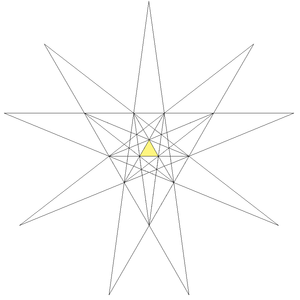|
|
http://www.youtube.com/watch?v=j9e0auhmxnc
Phi in the Bible
Although perhaps not immediately obvious, phi and the golden section also appear in the Bible. Also see the Theology page.
The Ark of the Covenant is a Golden Rectangle
|

|
In Exodus 25:10, God commands Moses to build the Ark of the Covenant, in which to hold His Covenant with the Israelites, the Ten Commandments, saying,
"Have them make a chest of acacia wood-
two and a half cubits long,
a cubit and a half wide,
and a cubit and a half high."
|
The ratio of 2.5 to 1.5 is 1.666..., which is as close to phi (1.618 ...) as you can come with such simple numbers and is certainly not visibly different to the eye. The Ark of the Covenant is thus constructed using the Golden Section, or Divine Proportion. This ratio is also the same as 5 to 3, numbers from the Fibonacci series.
In Exodus 27:1-2, we find that the altar God commands Moses to build is based on a variation of the same 5 by 3 theme:
"Build an altar of acacia wood, three cubits high; it is to be square, five cubits long and five cubits wide."
Note: A cubit is the measure of the forearm below the elbow.
|
 |
|
Noah's Ark uses a Golden Rectangle
|
In Genesis 6:15, God commands Noah to build an ark saying,
"And this is the fashion which thou shalt make it of: The length of the ark shall be three hundred cubits, the breadth of it fifty cubits, and the height of it thirty cubits."
Thus the end of the ark, at 50 by 30 cubits, is also in the ratio of 5 to 3, or 1.666..., again a close approximation of phi not visibly different to the naked eye. Noah's ark was built in the same proportion as ten arks of the covenant placed side by side.
|

|
The Number 666 is related to Phi
|

|
Revelation 13:18 says the following:
"This calls for wisdom. If anyone has insight, let him calculate the number of the beast, for it is a man's number. His number is 666."
|
| This beast, regarded by some as the Anti-Christ described by John, is thus related to the number 666, one of the greatest mysteries of the Bible.
Curiously enough, if you take the sine of 666º, you get -0.80901699, which is one-half of negative phi, or perhaps what one might call the "anti-phi." You can also get -0.80901699 by taking the cosine of 216º, and 216 is 6 x 6 x 6.
The trigonometric relationship of sine 666º to phi is based on an isosceles triangle with a base of phi and sides of 1. When this triangle is enclosed in a circle with a radius of 1, we see that the lower line, which has an angle of 306º on the first rotation and 666º on the second rotation, has a sine equal to one-half negative phi.
In this we see the unity of phi divided into positive and negative, analogous perhaps to light and darkness or good and evil. Could this "sine" be a "sign" as well?
In addition, 666 degrees is 54 degrees short of the complete second circle and when dividing the 360 degrees of a circle by 54 degrees you get 6.66... The other side of a 54 degree angle in a right angle is 36 degrees and 36 divided by 54 is .666.
Phi appears throughout creation, and in every physical proportion of the human body. In that sense it is the number of mankind, as the mysterious passage of Revelation perhaps reveals.
Also see the Theology page.
The colors of the Tabernacle are based on a phi relationship
The PhiBar program produces the colors that the Bible says God gave to Moses for the construction of the Tabernacle.
As it says in Exodus 26:1, "Make the tabernacle with ten curtains of finely twisted linen and blue, purple and scarlet yarn, with cherubim worked into them by a skilled craftsman."
Set the primary color of the PhiBar program to blue, the secondary color of the PhiBar to purple and it reveals the Phi color to be scarlet.
This reference to the combination blue, purple and scarlet in the construction of the tabernacle appears 24 times in Exodus 25 through 39, describing the colors to be used in the curtains, waistbands, breastpieces, sashes and garments.
See the Color page for additional information.
|
Insights on the Ark of the Covenant and 666 contributed by Robert Bartlett.
Insights on the Altar in Exodus 27 contributed by Sir Hemlock.
Insights on the Tabernacle colors contributed by J.D. Ahmanson.
http://goldennumber.net/bible.htm
|
|
|
|
|
|
ÓRBITA DE VENUS EN 1 ÓRBITA DE LA TIERRA
|
|
PHI: una relación cósmica.
|
Cuando tras 225 días Venus completa su órbita, la Tierra está en un punto de su órbita que está alineado con el punto de la órbita de Venus en el que éste estará cuando la Tierra complete su órbita (365 días), y cuando esto ocurre, Venus ha dado 1 órbita y 0'62 más, es decir que cubre 360 grados y 225 grados más de su órbita: 585 grados. Es lo mismo que decir que el año de la Tierra (365 días) es 1,62 veces más largo que el año de Venus (225 días).
Ver también el ciclo octogonal de Venus.
El número 1'62 es un redondeo del valor del número PHI (=1'6180) llamado el Número Áureo (o Número de Oro o Divina Proporción) como un valor proporcional que define el ritmo de crecimiento (un tipo de evolución) de muchos elementos de la naturaleza, empezando por las espirales y sus formas.
Esta evolución y relación PHI se sigue apreciando en el baile sincronizado de Venus y la Tierra, pues en su siguiente momento culmen después de 1 órbita de la Tierra y 1'62 de Venus, se encuentran en su punto más cercano y alineados con el Sol (al mismo lado de éste) cuando la Tierra ha realizado 1'6 órbitas (y Venus 2'6). Es el Ciclo Sinódico de Venus medido desde la Tierra.
¿Deseas conocer cuál es tu edad venusiana, es decir, según el Planeta Venus? Basta que multipliques tu edad por 1'62.
|
|
|
|
|
PHI es la 21a letra del AlfaBeto griego. El valor del número PHI es 1,6180339. Este número es la relación proporcional entre 6.765 y 4.181, primeros números enteros que la producen, es decir que 6.765 es 1'6180339 veces el número 4.181, o 6.765 dividido por 4.181 da PHI.
Estos dos números pertenecen a la llamada "serie de Fibonacci" y forman la 19º división. La serie reproduce mediante números enteros una secuencia de evolución entre crecimiento y proporción que las personas que lo han investigado dicen que se da en muchos elementos de la Naturaleza. Por eso se le da en llamar la Divina Proporción, el Número de Oro o el Número Áureo. En algunos casos nuestra propia intuición/corazón percibe la armonía/belleza subyaciendo a las proporciones de las formas sin necesidad de acudir al intelecto para realizar comprobaciones ni cálculos ni demostraciones a otros intelectos "alejados" de la intuición.
La serie es resultado de una lógica sencilla y consiste en que, comenzando por el número 1 el siguiente número es la suma de los dos anteriores. Así, si tenemos el 1 para obtener el siguiente hemos de sumar 0+1 que es 1. Y el siguiente es 1+1 que es 2, y así sucesivamente:
1 1 2 3 5 8 13 21 34 55 89 144 233 377 610 987 1597 2584 4181 6765...
El 144 es el 12º número de la serie y es el cuadrado de 12, es decir 12 x 12.
Las divisiones son:
1/1 = 1
2/1 = 2
3/2 = 1'5
5/3 = 1'666
8/5 = 1'6 (en 8 órbitas al Sol (8 años) la Tierra se encuentra 5 veces con Venus al mismo lado del Sol).
13/8 = 1'625 (relación entre el periodo orbital de la Tierra y de Venus: 365 días / 225 días. En 13 órbitas de Venus, la Tierra da 8 órbitas).
21/13 = 1'6153846
34/21 = 1'6190476
55/34 = 1'617647
89/55 = 1'6181818. Primera división que produce 3 decimales.
144/89 = 1'6179775
233/144 = 1'6180555. División que da 4 decimales.
377/233 = 1'6180257
610/377 = 1'6180371
987/610 = 1'6180327
1597/987 = 1'6180344
2584/1597 = 1'6180338
4181/2584 = 1'6180340
6765/4181 = 1'6180339
El número Phi, como el Pi, no es entero. Su valor con 3 decimales es 1'618. Si lo sumamos a sí mismo una y otra vez llegaremos a un valor cuasientero, el 88'99, prácticamente 89, tras 55 sumas.
1'618 x 55 = 88'99 ó 89. La curiosidad, al "integrar" phi (nada que ver con "integrales") o estirarlo 55 veces dando 89, es que los números 55 y 89 son números consecutivos de la serie. Y el siguiente cuasientero es 144'002 = Phi x 89, ó Phi escalado 89 veces. El 144 es el 12º número de la serie y es el cuadrado de 12, es decir 12 x 12.
En la siguiente animación puedes construir una espiral como las de las conchas de los nautilus en base a una estructura geométrica basada en cuadrados proporcionales. Puedes pulsar sobre el punto rojo para iniciar la construcción. |
|
|
|
|
La naturaleza es obstinada, tiene muchos recursos y es sorprendentemente sabia. Las especies, para no extinguirse, mutan, se hibridan, se adaptan a nuestras agresiones, hibernan, estivan, las mejores y las más fuertes sobreviven. No todo está perdido.
sábado 13 de agosto de 2011
Genética estructural: el número áureo Phi ( φ )
El número aúreo o número phi, representado con la letra griega φ en honor al escultor griego Fidias, es un concepto matemático que hace referencia a una curiosa proporción entre segmentos de líneas rectas que puede observarse en la naturaleza (flores, hojas, ramas, raíces, moluscos, estrellas de mar, estructuras de coral, cristales de roca, copos de nieve, proporción ideal entre las partes del cuerpo humano, etc...) y en ciertas figuras geométricas (triángulo, círculo, cuadrado, rectángulo, estrella, elipse, rombo, cubo, esfera, pentágono, tetraedro, octaedro, icosaedro, dodecaedro, etc..). Es un número algebraico irracional, un decimal infinito no periódico, que no puede ser reducido ni fraccionado.
Fué descrito y estudiado por primera vez por Euclides hacia el año 300 a. C. En la Edad Media se le atribuyó un carácter estético y divino considerando perfectas las proporciones que seguían los principios del número áureo. Su fórmula matemática es φ = 1 + √5 / 2 = 1´6180339887.......hasta el infinito. La Raiz cuadrada de 5 es también un número algebraico irracional con un valor infinito.
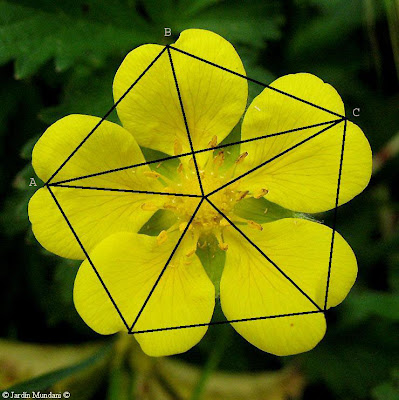 φ = AC / BC = 1´61803.
En esta flor de Potentilla reptans es muy fácil encontrar el numero áureo uniendo con líneas rectas las escotaduras de cada uno de sus cinco pétalos dibujando un pentágono regular. Luego basta trazar otra línea recta uniendo las escotaduras de dos pétalos no contíguos y obtenemos los dos valores para calcular el número áureo. A veces el número obtenido no es exacto aunque muy aproximado. Para afinar más el resultado se pueden obtener los valores de cada uno de los cinco ángulos del pentágono y sacar la media, con lo que se obtiene un número áureo prácticamente exacto.
φ = AB / BC = 1´61803.
En esta flor de Eruca sativa es también muy fácil encontrar dos valores para calcular el número áureo. Al tener cuatro pétalos idénticos es suficiente con dibujar una línea recta uniendo cada dos pétalos con lo que se obtiene un cuadrado perfecto. Luego se unen los cuatro lados del cuadrado con dos líneas que se crucen en el centro de la flor y se obtienen cuatro cuadrados idénticos más pequeños. Trazando una línea en diagonal que vaya desde el ángulo de un cuadrado hasta el ángulo opuesto de un cuadrado contíguo se obtiene el primer valor AB. El otro valor BC se obtiene dibujando una línea diagonal que una dos ángulos opuestos de un mismo cuadrado.
φ = AB / BC = 1´61803.Esta pequeña flor de Ophrys speculum tiene la belleza mística atribuída por los matemáticos a las formas que cumplen con las proporciones del número áureo. Fué muy sencillo encontrar dos valores para calcularlo con una exactitud asombrosa.
Las propiedades y posibles aplicaciones de este número euclidiano han sido profusamente estudiadas por los matemáticos desde el siglo dieciocho hasta la actualidad, dando lugar a diversos teoremas, ecuaciones y fórmulas matemáticas, como el famoso Teorema de Kolmogórov–Arnold–Moser o teorema KAM.
Se ha encontrado una estrecha relación entre el número áureo y la Secuencia de Fibonacci. Ambos conceptos matemáticos están ampliamente representados en la naturaleza.
φ = AB / CD = 1´61803.Esta pequeña flor casi albina de Solenopsis minuta subsp. balearica, endémica de Mallorca, tiene también una estructura en la forma y distribución de sus cinco pétalos que parece diseñada por un matemático. Un simple trazo uniendo los vértices de los dos pétalos laterales mayores nos da el primer valor AB y otro trazo uniendo los vértices de los dos pétalos menores nos da el otro valor CD. La sencillez y la belleza del diseño son asombrosas. El número áureo obtenido es sorprendentemente exacto.
φ = AB / AC = 1´61803. φ = AB / BC = 1´61803. Esta flor de azucena marina, Pancratium maritimum, de un blanco inmaculado y una simetría perfecta cuenta con un diseño que facilita mucho encontrar dos valores para calcular el número áureo. El primer valor AB se obtiene uniendo con una línea recta los vértices de dos pétalos opuestos. Para encontrar el segundo valor se trazan dos líneas que van desde el vértice de cada uno de los dos pétalos anteriores hasta el vértice de un pétalo no contíguo. Estas dos líneas se cruzan en el punto C y forman un aspa con dos brazos largos y dos brazos cortos. Cada uno de los brazos largos es el segundo valor.
 φ = AB / CD = 1´61803.
φ = CD / EF = 1´61803.
En las hojas es algo más complicado encontrar dos valores que nos permitan obtener un número áureo exacto. Sin embargo en esta hoja de zarzamora canaria, Rubus palmensis, las medidas de sus seis folíolos tienen unos valores decrecientes que al dividirlos entre ellos nos dan un resultado sorprendentemente exacto.
φ = AC / AB = 1´61803. Y finalmente otro ejemplo de una planta canaria, la Hedera canariensis, fotografiada en el bellísimo Bosque de Los Tiles de la Isla de la Palma. Sus hojas acorazonadas de una simetría perfecta nos permiten hallar con facilidad dos líneas diagonales que al dividirse entre ellas nos dan el número áureo, el número mágico de la belleza divina y la perfección.
A lo largo de los siglos esta proporción matemática con ejemplos tan abundantes en los seres vivos y en las rocas ha sido utilizada por los pintores, escultores y arquitectos para realizar sus obras más bellas en un afan por plasmar el ideal de perfección, simetría y equilibrio que tan sabiamente diseña la naturaleza.
|
|
|
|
|
EL INICIO DEL CALENDARIO MAYA TIENE FUERTE NEXO CON EL NUMERO DE ORO, LA ROTACION DE VENUS (225 DIAS) Y EL COMIENZO DEL AÑO NUEVO JULIANO/GREGORIANO-¿ADONDE APRENDIERON LOS MAYAS ESTOS CODIGOS?
hoy hice un gran hallazgo, acerca del numero fi(la divina proporcion-numero aureo)
 bueno, sabemos que fi (Φ) es un numero irracional, su aproximacion es 1.61803399  tiene miles de aplicaciones y ejemplos concretos en la naturaleza y en figuras geometricas. ademas hay construcciones de la era griega en la que la estructura va con la divina proporcion, como las dimensiones del panteon. bueno, si aplicamos el numero aureo a los dias del año, 1.618, se separan las dos partes con el 13 de agosto en el medio, asi: dias entre 1 de enero hasta 12 de agosto------- 13 de agosto---dias entre 14 de agosto a 31 de diciembre, y la division obtenida va con el numero aureo, con una proporcion de 1.618:1 o sea, 225 dias(desde 1/1 hasta 13/8) dividido por 140(dias restantes desde 13/8 hasta 31/12) dias= 225/140~=1.607~=1.61803399 
|
|
|
|
|
|
The Golden Mean can be construed as the basis of philosophy and Sacred Geometry, one of the Transcendental Numbers, [*] and is typically derived from Fibonacci Numbers. [* Technically, from a strictly mathematical standpoint -- as has been pointed out by several readers -- the Golden Mean, Phi, is the solution to a polynomial equation and thus not mathematically transcendental. However, if one looks at the other definitions of transcendental, most would agree that it qualifies.]
According to Robert Lawlor [1], “Ancient geometry rests on no a priori axioms or assumptions. Unlike Euclidian and the more recent geometries, the starting point of ancient geometric thought is not a network of intellectual definitions or abstractions, but instead a meditation upon a metaphysical Unity, followed by an attempt to symbolize visually and to contemplate the pure, formal order which springs forth from this incomprehensible Oneness. It is the approach to the starting point of the geometric activity which radically separates what we may call the sacred from the mundane or secular geometries. Ancient geometry begins with One, while modern mathematics and geometry being with Zero.”
Other authors have noted that “Both the ancient Greeks and the ancient Egyptians used the Golden Mean when designing their buildings and monuments.” “Artists as diverse as Leonardo da Vinci and George Seurat used the ratio when constructing their paintings. These artists and architects discovered that by utilizing the ratio 1 : 1.618..., they could create a feeling of order in their works. Even today, artists are still using this proportion in their works, and scientists, like Roger Penrose are discovering new things about the Golden Mean and its place in science, mathematics, and nature.”
<http://www.mcs.surrey.ac.uk/Personal/R.Knott/Fibonacci/fibInArt.html> is an excellent website on the subject, and notes among many other things, the connection with classical music and the Golden Mean. In a 1996 article in the American Scientist, for example, Mike Kay reported that Mozart’s sonatas were divided into two parts exactly at the Golden Mean point in almost all cases. Inasmuch as Mozart’s sister had said that Amadeus was always playing with numbers and fascinated by mathematics, it appears that this was either a conscious choice or an intuitive one. Meanwhile, Derek Haylock noted that in Beethoven’s Fifth Symphony (possibly his most famous one), the famous opening “motto” appears in the first and last bars, but also at the Golden Mean point (0.618) of the way through the symphony, as well as 0.382 of the way (i.e., the Golden Mean squared). Again, was it by design or accident? Keep in mind that Bartók, Debussy, Schubert, Bach and Satie may have also deliberately used the Golden Mean in their music.
(6/6/05) Another excellent website is http://goldennumber.net. This one even includes phi to 20,000 decimal places -- just in case you need this for your next term paper. In particular, one might also want to check out Pascal's Triangle. The latter is just too strange for words, incorporating as it does Fibonacci Numbers.
In a much more esoteric vein, Ronald Holt, Director, of the Flower of Life Research has included in <http://www.floweroflife.org/spiral01.htm>, “To The Golden Spiral In All of Us” (dated April 21, 1999), in which he notes, “Sacred geometry is the study of geometric forms and their metaphorical relationships to human evolution as well as a study in fluid evolutionary transitions of mind, emotions, spirit, and consciousness reflected in the succeeding transition from one sacred geometric form (consciousness state) into another.”
Furthermore, “True sacred geometric forms never fixate or stagnate on one single form. Instead they are actually in constant fluid transcendence and change (evolve or devolve) from one geometric form to another at their own speed or frequency."
(5/31/05) The Golden Spiral, in fact, has been found in Crop Circles -- sort of Mother Nature's "performance art" in wheat and other crop fields -- and thus do sort of grow on you. An excellent description of this design is given by ka-gold's golden spiral.
FfFfFfFfFfFfFfFfFfFfFfFfFfFfFfFfFfFfFfFfFfFfFfFfF
The Golden Mean can be determined via geometry by taking a square with all sides equal to 1, drawing an arc with the center of radius at the midpoint of one side and through the corner of an opposite side, and extending the original side to where it intersects the arc.
The length of the extension will then exactly equal f [and the base’s total length being F.] From this same geometry, we can calculate F by noting that the diagonal in the square from the midpoint of one side to an opposite corner is equal to the square root of the sum of the squares of the opposite sides (i.e. 1 and 1/2) as per the Pythagorean Theorem. From this, we calculate the square root of 5/4 (1.11803398875...), and then add 1/2 the side, to obtain 1.61803398875...
The ancient Greeks, who were really into aesthetic geometric appeal, established as one of their primary axioms concerning proportion, to always use the golden mean in dividing a line, i.e. dividing it at a point, C, on the line AB:
A________________C_________B
such that:
AB/AC = AC/BC = 1.6180339875...
For clarity, the Golden Mean can be assumed to be either one of two values, given by [2]:
F = 1.61803 39887 49894 84820 45868 34365 63811 77203 09180...
or
f = 0.61803 39887 49894 84820 45868 34365 63811 77203 09180...
The Golden Mean, the number, is the only number in which, among other things, satisfies the mathematical relationships:
F = 1/F + 1 ; f = 1/f - 1
For the esoteric crowd, f can also be represented by the very strange equation:
f = 1 + 1/{1 + 1/[1 + 1/(1 + 1/{1 + 1/[1 + 1/(1 + ...)]})]}
Another way to view the above equation is to think of it as representing rabbits attempting to draw their family tree in a furry, more prolific version of Roots. [This aside is reference to one original example of the usefulness of Fibonacci Numbers, which mathematically is the easiest manner to obtain the values of the Golden Mean (and to as many powers as one might like) by simply dividing one member of the Fibonacci Series with another.]
In fact, the Golden Mean Mathematics is a whirlwind of fascinating mathematical ideas and curiosities. Suffice it to say -- for the mathematically-less-inclined -- that the Golden Mean is: 1) intimately tied to the number 5 (and in particular to regular pentagons and five-pointed stars), 2) relates directly to the ideal human body (i.e. the Golden Mean raised to various powers are indicative of the body’s proportions), and 3) has been used extensively in ancient (and modern!) architecture -- among other things.
In the relationship between F, f, and 5 (they even sound alike!), we take a 5-pointed star -- the points of which form an inscribed five-sized, regular pentagon. By an arbitrary choice of measurement units, the length of a line drawn from one point of the star to an opposite point, can be set equal to f. This results in the line between two adjacent points (one side of the pentagon) automatically equaling f2. The line from a point to the interior pentagon is then f3, the side of the interior pentagon is f4, and so forth, ad infinitum. Then by connecting these points in sequence, we suddenly discover we’ve been thrown a curve: a new geometrical delight known as The Golden Spiral.
We might also mention in passing that the connection of the Golden Mean to the five-pointed star may be why the sacred practice of Wicca seems so preoccupied with this universal symbol -- regardless of whether or not their practitioners fully understand the significance. (Or why flags of many nations, states, or corporations -- the latter such as Texaco and others -- all enthusiastically use the five pointed star! Not that these nations, states, etceteras, are practicing Wicca, but... Well... You understand!)
With respect to the body proportions, this point can be demonstrated by taking the measurements of the average of many people -- with women’s measurements (for some inexplicable reason) approaching the ideal more closely than men -- whereupon we find that the position of the navel (a human’s first channel of nourishment and life) divides the body’s height at precisely the Golden Mean. Furthermore, if the distance from the brow (top of the eye) to the nose is 1, then the distance from the brow to the crown is F. Going in the opposite direction, the distance from the nose to the base of the neck is F, the neck to the armpit is F2, the armpit to the navel is F3, the navel to the reach of the fingers is F4, and the distance from the fingertips to the soles is F5. On a smaller scale, in measuring the length of the bones in the human hand, we find measurements of 1, F, F2, and F3 (the last bone being within the palm of the hand).
The below drawings, courtesy of Michael S. Schneider [3], emphasize these points.
Beginning to get a hand on this? Michael S. Schneider [3], for example, notes that: “The body’s structure is a mirror of our psyche, a denser expression of the energetic patterns of our soul. Body and soul somehow partake of the same design. But in what way can a mathematical ratio permeate our souls? Through beauty. A deep part of ourselves recognizes in flowers and dancers the beauty of the mathematical infinite and sees in it the endlessness of our own depths. Natural beauty resonates with the archetypal nature within us.”
On a decidedly more mundane application of such “natural beauty”, investors in the stock market have used the delights of the Golden Mean for the purpose of making money and, hopefully, large wheelbarrows of it! As it turns out, F and f are important in the stock market, where the index averages (such as the Dow Jones Industrial Average) typically rise a certain number of points (say a hundred), and then fall back a number of points equal to 0.618 x 100, before again rising to new heights. The amount of the initial leg of this cycle is not always clear, but the retreat path is much more clearly defined.
Obviously, this cyclical nature also works in the opposite direction as well (a fact which novice investors might want to keep in mind). It must be noted that there are any number of variations in the amount of the market’s rise and fall, as well as variations in the time periods from minutes to decades. In effect, there are numerous cycles within cycles within cycles. Nevertheless, this predictive technique (known as Elliott Wave Theory) has been practiced successfully by numerous stock market analysts, who seem to have an unusually deep appreciation for F Lo Sophia and the money it can effortlessly make them.
There now seems to be a justifiable reason for our ancient ancestors having such a reverence toward the Golden Mean. Besides The Great Pyramids, their architecture showed it through such examples as the west facade of the Greek Parthenon, which perfectly fits within a golden rectangle (whose dimensions are 1 and F). The west facade of the Notre Dame Cathedral in Paris is also loaded with Golden Mean ratios, and more recently, the United Nations Building in New York City is designed as three golden rectangles (equivalent to three Parthenons stacked upon one another). Perhaps we shouldn’t attribute all our knowledge of the Golden Mean to the ancients, as such examples of Sacred Geometry keep cropping up in more modern structures. At least those designed by more “enlightened” architects.
Why? Because even artists with absolutely no interest in math (or an aversion to the subject) will inevitably respond to the beauty in the architecture which arises from the mathematics! This is likely true of everything from “cubism” to Mozart. For it is the mathematical resonance within the sacred geometry symbolism which touches our soul.
The Golden Mean also touches such intriguing phenomena as The Fifth Element, the Harmony of the Spheres, Connective Physics, Philosophy and the Tree of Life.
|
|
|
|
|
Golden Ratio
The golden section is a line segment divided according to the golden ratio: The total length a + b is to the length of the longer segment a as the length of a is to the length of the shorter segment b
In mathematics and the arts, two quantities are in the golden ratio if the ratio of the sum of the quantities to the larger quantity is equal tothe ratio of the larger quantity to the smaller one. The golden ratio is an irrationalmathematical constant, approximately 1.6180339887.[1] Other names frequently used for the golden ratio are the golden section (Latin: sectio aurea) and golden mean.[2][3][4] Other terms encountered include extreme and mean ratio,[5] medial section,divine proportion, divine section (Latin:sectio divina), golden proportion, golden cut,[6] golden number, and mean of Phidias.[7][8][9] In this article the golden ratio is denoted by the Greek lowercase letter phi (  ) , while its reciprocal, ) , while its reciprocal,  or or  , is denoted by the uppercase variant Phi ( , is denoted by the uppercase variant Phi ( ). ).
Icosahedron Gold nanoparticle viewed in electron microscope.
Our Galena lead was polished following the Golden ratio and so converted into a Gold icosahedron
The ark of the Covenant
Detailed instructions[10] are given by God for the plan of the Ark: it is to be 2½ cubits in length, 1½ in breadth, and 1½ in height (as 21⁄2×11⁄2×11⁄2 royal cubits or 1.31×0.79×0.79 m). Then it is to be plated entirely with gold, and a crown or molding of gold is to be put around it. Four rings of gold are to be put into its four feet—two on each side—and through these rings staves of shittim-wood overlaid with gold for carrying the Ark are to be inserted; and these are not to be removed. A golden cover, adorned with golden cherubim, is to be placed above the Ark.
Although perhaps not immediately obvious, phi and the golden section also appear in the Bible.
|
|
In Exodus 25:10, God commands Moses to build the Ark of the Covenant, in which to hold His Covenant with the Israelites, the Ten Commandments, saying,
"Have them make a chest of acacia wood-
two and a half cubits long,
a cubit and a half wide,
and a cubit and a half high."
|
The ratio of 2.5 to 1.5 is 1.666..., which is as close to phi (1.618 ...) as you can come with such simple numbers and is certainly not visibly different to the eye. The Ark of the Covenant is thus constructed using the Golden Section, or Divine Proportion. This ratio is also the same as 5 to 3, numbers from the Fibonacci series.
In Exodus 27:1-2, we find that the altar God commands Moses to build is based on a variation of the same 5 by 3 theme:
"Build an altar of acacia wood, three cubits high; it is to be square, five cubits long and five cubits wide."
Note: A cubit is the measure of the forearm below the elbow. |
 |
|
Note : Acacia Wood synonym of Bitterness
Noah's Ark uses a Golden Rectangle
|
In Genesis 6:15, God commands Noah to build an ark saying,
"And this is the fashion which thou shalt make it of: The length of the ark shall be three hundred cubits, the breadth of it fifty cubits, and the height of it thirty cubits."
Thus the end of the ark, at 50 by 30 cubits, is also in the ratio of 5 to 3, or 1.666..., again a close approximation of phi not visibly different to the naked eye. Noah's ark was built in the same proportion as ten arks of the covenant placed side by side.
|
|
The Number 666 is related to Phi
|
|
Revelation 13:18 says the following:
"This calls for wisdom. If anyone has insight, let him calculate the number of the beast, for it is a man's number. His number is 666."
|
This beast, regarded by some as the Anti-Christ described by John, is thus related to the number 666, one of the greatest mysteries of the Bible.Curiously enough, if you take the sine of 666º, you get -0.80901699, which is one-half of negative phi, or perhaps what one might call the "anti-phi." You can also get -0.80901699 by taking the cosine of 216º, and 216 is 6 x 6 x 6.
The trigonometric relationship of sine 666º to phi is based on an isosceles triangle with a base of phi and sides of 1. When this triangle is enclosed in a circle with a radius of 1, we see that the lower line, which has an angle of 306º on the first rotation and 666º on the second rotation, has a sine equal to one-half negative phi.
In this we see the unity of phi divided into positive and negative, analogous perhaps to light and darkness or good and evil. Could this "sine" be a "sign" as well?
In addition, 666 degrees is 54 degrees short of the complete second circle and when dividing the 360 degrees of a circle by 54 degrees you get 6.66... The other side of a 54 degree angle in a right angle is 36 degrees and 36 divided by 54 is .666.
Phi appears throughout creation, and in every physical proportion of the human body. In that sense it is the number of mankind, as the mysterious passage ofRevelation perhaps reveals.
|
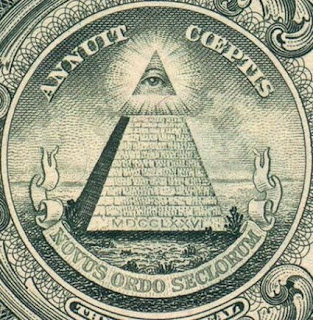
The Illuminati (plural of Latin illuminatus, "enlightened") is a name given to several groups, both historical and modern, and both real and fictitious. Historically, the name refers specifically to the Bavarian Illuminati, an Enlightenment-era secret society founded on May 1, 1776.
In modern times it is also used to refer to a purported conspiratorial organization which acts as a shadowy "power behind the throne", allegedly controlling world affairs through present day governments and corporations, usually as a modern incarnation or continuation of the Bavarian Illuminati. In this context, the Illuminati are believed to be the masterminds behind events that will lead to the establishment of a New World Order.
 |
A regular square pyramid is determined by its medial right triangle, whose edges are the pyramid's apothem (a), semi-base (b), and height (h); the face inclination angle is also marked. Mathematical proportions b:h:a of  and and  and and  are of particular interest in relation to Egyptian pyramids. are of particular interest in relation to Egyptian pyramids. |
|
|
|
|
|
Octahedron or bipyramid
The vertices of the octahedron lie at the midpoints of the edges of the tetrahedron, and in this sense it relates to the tetrahedron in the same way that the cuboctahedron and icosidodecahedron relate to the other Platonic solids. One can also divide the edges of an octahedron in the ratio of the golden mean to define the vertices of an icosahedron. This is done by first placing vectors along the octahedron's edges such that each face is bounded by a cycle, then similarly partitioning each edge into the golden mean along the direction of its vector. There are five octahedra that define any given icosahedron in this fashion, and together they define a regular compound.
Note {3,3} is the tetrahedron, {3,4} the octahedron followed by the icosahedron {3,5}
Icosahedron
It has five triangular faces meeting at each vertex. It can be represented by itsvertex figure as 3.3.3.3.3 or 35, and also by Schläfli symbol {3,5}. It is the dual of the dodecahedron, which is represented by {5,3}, having three pentagonal faces around each vertex.
Vertex figure of the Icosahedron
3.3.3.3.3
Vertex figure of the octahedron or bipyramid
3.3.3.3
 |
The owl ( Moloch ) Symbol of wisdom
Present in the dollar bill and the Bohemian Groove
|
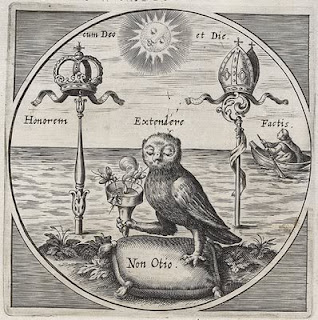 |
| The pact with Satan ( Golden fleece ) and the owl symbolizing wisdom |
Dimensions of the icosahedron
If the edge length of a regular icosahedron is a, the radius of a circumscribed sphere (one that touches the icosahedron at all vertices) is

and the radius of an inscribed sphere (tangent to each of the icosahedron's faces) is

while the midradius, which touches the middle of each edge, is

Remember
Curiously enough, if you take the sine of 666º, you get -0.80901699, which is one-half of negative phi, or perhaps what one might call the "anti-phi." You can also get -0.80901699 by taking the cosine of 216º, and 216 is 6 x 6 x 6.
Electron microscopy suggests that many viruses are roughly spherical. A detailed examination shows that they are actually icosahedral. Icosahedral viruses are very common plant and animal viruses. The HIV capsid layer is thought to have an icosahedral structure. At the moment precise details of the HIV capsid structure are not known but some general considerations are described below:
The subunits of the capsid are located around the vertices or face of an icosahedron. An icosahedron has 20 equilateral triangles arranged around the face of a sphere. It is defined by having 2, 3 and 5 fold axis of symmetry.
Cartesian coordinates of the Icosahedron ( 3 Golden rectangles )
  If we join mid-points of the dodecahedron's faces, we can get three rectangles all at right angles to each other. What's more, they are Golden Rectangles since their edges are in the ratio 1 to Phi. The same happens if we join the vertices of the icosahedron since it is the dual of the dodecahedron. |
|
|
|
|
Using these golden rectangles it is easy to see that the coordinates of the icosahedron are as given above since they are:
(0,± 1, ± Phi), (± Phi, 0, ± 1), (± 1, ± Phi, 0) .
Icosahedron net
A geodesic gridis a technique used to model the surface of a sphere (such as the Earth) with a subdividedpolyhedron, usually an icosahedron.
Geodesic Dome
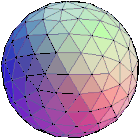  A geodesic sphere and its dual.Stellation of the Icosahedron According to specific rules defined in the book The fifty nine icosahedra, 59 stellations were identified for the regular icosahedron. The first form is the icosahedron itself. One is a regular Kepler-Poinsot polyhedron. Three are regular compound polyhedra
The stellation diagram for the icosahedron with the central triangle marked for the original icosahedronNote 9 pointed star
Official 911 emergency logo
Another version
Stellation diagram with numbered cellsNote 6 elevens, 6 nines and 6 six surrounding the inverted triangle A geodesic sphere and its dual.Stellation of the Icosahedron According to specific rules defined in the book The fifty nine icosahedra, 59 stellations were identified for the regular icosahedron. The first form is the icosahedron itself. One is a regular Kepler-Poinsot polyhedron. Three are regular compound polyhedra
The stellation diagram for the icosahedron with the central triangle marked for the original icosahedronNote 9 pointed star
Official 911 emergency logo
Another version
Stellation diagram with numbered cellsNote 6 elevens, 6 nines and 6 six surrounding the inverted triangle
Note: nine 13 pointed stars
Because of this annual exorcism of the noxious spirits of the dead, the whole month of May was rendered unlucky for marriages, whence the proverb Mense Maio malae nubent ("They wed ill who wed in May").
In the Julian calendar the three days of the feast were 9, 11, and 13 May. The myth of origin of this ancient festival, according to Ovid, who derives Lemuria from a supposed Remuria[2] was that it had been instituted byRomulus to appease the spirit of Remus (Ovid, Fasti, V.421ff; Porphyrius ). Ovid notes that at this festival it was the custom to appease or expel the evil spirits by walking barefoot and throwing black beans over the shoulder at night. It was the head of the household who was responsible for getting up at midnight and walking around the house with bare feet throwing out black beans and repeating the incantation, "I send these; with these beans I redeem me and mine (haec ego mitto; his redimo meque meosque fabis.)." nine times. The household would then clash bronze pots while repeating, "Ghosts of my fathers and ancestors, be gone!"[3] nine times.
On what had been the culminating day of the Lemuralia, May 13 in 609 or 610— the day being recorded as more significant than the year—, Pope Boniface IV consecrated the Pantheon at Rome to the Blessed Virgin and all the martyrs, and the feast of that dedicatio Sanctae Mariae ad Martyres has been celebrated at Rome ever since. According to cultural historians,[4] this ancient custom was Christianized in the feast of All Saints' Day, established in Rome first on May 13, in order to de-paganize the Roman Lemuria,[5] while others see a link to the May 13 date in Saint Ephrem's celebration of All Saints on that day in the 4th century.[6]
The number, "13" is considered divine by the occultist for a couple of reasons:
1. The Bible assigns '13' the meaning of "rebellion against constituted authority", plus the depravity that caused Satan to rebel against God.
2. The occultist assigns '6' to represent the number of man, and the number '7' to represent the number of divine perfection. Thus, as a person climbs that "Jacob's Ladder" toward self-perfection in the realm of the occult, the number '13' represents the state of divine perfection, self-achieved perfection, and Illumination (6+7 = 13).
Thus, the occult calendar is comprised of four periods of 13 weeks each. We list these periods for you, below.
Then, after listing them, we shall come back to talk about each of them in detail.
1. Winter Solstice - 13 weeks - Minor sabbath
a. December 21 - Yule
b. December 21-22 - Winter Solstice/Yule. One of the Illuminati's Human Sacrifice Nights
c. February 1 and 2 - Candlemas and Imbolg, a.k.a. Groundhog's Day. One of the Illuminati's Human Sacrifice Nights
d. February 14 - Valentine's Day
2. Spring Equinox - 13 weeks - Minor sabbath but does require human sacrifice
a. March 21-22 - Goddess Ostara - Note: Easter is the first Sunday after the first new moon after Ostara. March 21 is one of the Illuminati's Human Sacrifice Nights
b. April 1 - All Fool's Day, precisely 13 weeks since New Year's Day!
c. April 19 - May 1 - Blood Sacrifice To The Beast. Fire sacrifice is required on April 19.
d. April 30 - May 1 - Beltaine Festival, also called Walpurgis Night. This is the highest day on the Druidic Witch's Calendar. May 1 is the Illuminati's second most sacred holiday. Human sacrifice is required
|
|
|
|
|
DaVinci’s Vitruvian Man
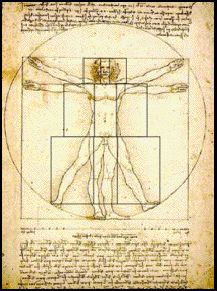
The Vetruvian Man"(The Man in Action)" by Leonardo Da Vinci
We can draw many lines of the rectangles into this figure. Then, there are three distinct sets of Golden Rectangles: Each one set for the head area, the torso, and the legs.
DaVinci named his drawing after Marcus Vitruvius Pollo, who as a 1st century Roman architect that stated ‘the height of a well-proportioned man is equal to the span of his outstretched arms, these two equal measured yield a square which encompasses the whole body, while the hands and feet touch a circle centered upon the navel.”
Vitruvius was a proponent of the ‘Sacred Geometry of Pythagoras’ and designed temples based upon the proportions of the human body.
Symboldictionary.net
According to Pythagorian tradition, the circle represents the spiritual realm; the square, material existence, so the human body represented the perfect marriage of matter and spirit, which was is reflected in its proportions. This perfection, wrote Vitruvius, was evidenced by the fact that the extended limbs of a perfectly proportioned human fit into both the circle and the square.
Kenneth Clark in his biography of DaVinci on pg 76 wrote:
“…for if man was the measure of all things, physically perfect man was surely the measure of all beauty, and his proportions must in some way be reducible to mathematical terms and correspond with those abstract perfections, the square, the circle, and the golden section.”
In short, Vitruvian man represents the ‘perfect man.’ The Beast.
Rev 13:18 Here is wisdom: Let the one having reason count the number of the beast, for it is the number of a man and its number is six hundred and sixty six.
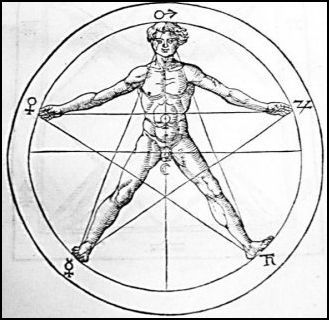
The Fibonacci pattern/Phi points to the mark
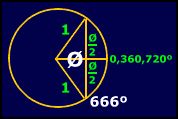
http://goldennumber.net/bible.htm
“This beast, regarded by some as the Anti-Christ described by John, is thus related to the number 666, one of the greatest mysteries of the Bible.
Curiously enough, if you take the sine of 666º, you get -0.80901699, which is one-half of negative phi, or perhaps what one might call the “anti-phi.” You can also get -0.80901699 by taking the cosine of 216º, and 216 is 6 x 6 x 6.
The trigonometric relationship of sine 666º to phi is based on an isosceles triangle with a base of phi and sides of 1. When this triangle is enclosed in a circle with a radius of 1, we see that the lower line, which has an angle of 306º on the first rotation and 666º on the second rotation, has a sine equal to one-half negative phi.
In this we see the unity of phi divided into positive and negative, analogous perhaps to light and darkness or good and evil. Could this “sine” be a “sign” as well?
In addition, 666 degrees is 54 degrees short of the complete second circle and when dividing the 360 degrees of a circle by 54 degrees you get 6.66… The other side of a 54 degree angle in a right angle is 36 degrees and 36 divided by 54 is .666.
Phi appears throughout creation, and in every physical proportion of the human body. In that sense it is the number of mankind, as the mysterious passage of Revelation perhaps reveals.”
http://www.biblewheel.com/gr/gr_216.asp
The Number 216 is the cube of 6 – the Number God used in the foundation of the Creation Holograph. It is the value of the Davir (Holie of Holies, called the Oracle in the verse above) which God designed as a physical cube of 20 x 20 x 20 cubits:

These identities integrate with the Holiness of the Number 6, which is the Number the Lord God Almighty used to construct the Cosmos (= 600). This is why the “Man of Sin” who sits in the Holy of Holies shewing himself to be God, is marked by the Number 666. It is his attempt to sit in God’s Holy Place.

Further linking this concept together is the fact that the Ark of the Covenant was designed according to the Fibonacci pattern.
http://goldennumber.net/bible.htm
The Ark of the Covenant is a Golden Rectangle
In Exodus 25:10, God commands Moses to build the Ark of the Covenant, in which to hold His Covenant with the Israelites, the Ten Commandments, saying,
“Have them make a chest of acacia wood- two and a half cubits long, a cubit and a half wide, and a cubit and a half high.”
The ratio of 2.5 to 1.5 is 1.666…, which is as close to phi (1.618 …) as you can come with such simple numbers and is certainly not visibly different to the eye. The Ark of the Covenant is thus constructed using the Golden Section, or Divine Proportion. This ratio is also the same as 5 to 3, numbers from the Fibonacci series.
In Exodus 27:1-2, we find that the altar God commands Moses to build is based on a variation of the same 5 by 3 theme:
“Build an altar of acacia wood, three cubits high; it is to be square, five cubits long and five cubits wide.”
Note: A cubit is the measure of the forearm below the elbow.
The cubit is based on the Fibonacci pattern/Phi as well.

To further connect these ideas, the following is a study done from the author of the BibleWheel, Richard McGough.
http://www.biblewheel.com/GR/GR_666.asp

 The essential holiness of the Number 666 can not be denied. It is designed by God. It marks the Beast because the Beast seeks to blaspheme God and sit in the Holy Place, exactly where the Holy Ark = 666 sat! The essential holiness of the Number 666 can not be denied. It is designed by God. It marks the Beast because the Beast seeks to blaspheme God and sit in the Holy Place, exactly where the Holy Ark = 666 sat!
As a finally example, we have these multiple occurrences of the phrase “of/from God”:
In each case, the highlighted words are translated from the Greek phrase “para Theou.” We have the identity:

Yahshua came ‘Para Theou’
John 1.6: There was a man sent from God, whose name was John.
John 9.16: Therefore said some of the Pharisees, This man is not of God, because he keepeth not the sabbath day. Others said, How can a man that is a sinner do such miracles? And there was a division among them.
John 9.33: If this man were not of God, he could do nothing.
2 Peter 1.17: For he received from God the Father honour and glory, when there came such a voice to him from the excellent glory, This is my beloved Son, in whom I am well pleased.
2 John 3: Grace be with you, mercy, and peace, from God the Father, and from the Lord Jesus Christ, the Son of the Father, in truth and love.
In light of these identities, we must understand that God Himself is revealing the Number 666 as His own Number which marks the true intent of the the Devil, the Pseudochrist – i.e. False Christ, the true meaning of Antichrist – who would if he could, sit upon God’s Throne in the Holy of Holies, “shewing himself that he is God.”
The Holy of Holies had no light in it at all. The Holy Ark (= 666) – where God said He would meet with Moses – sat in complete darkness. This corresponds exactly with what the Lord said of Himself through the Prophet David in Psalm 18.11:
He made darkness his secret place; his pavilion round about him were dark waters and thick clouds of the skies.

His Secret Place is related to the Temple, in specific the Holy of Holies
Eze 7:22 I also will turn My face from them, and they shall defile My hidden place. And violent ones shall enter into it and defile it.
Psa 91:1 He who dwells in the secret place of the Most High shall abide in the shade of the Almighty.
Deu 27:15 Cursed is the man who makes a carved and molten image, an abomination to YHWH, the work of a craftsman’s hands, and who sets it up in a secret place! And all the people shall answer and say, Amen!
In the ark was placed the Word, which also linked to the Fibonacci Spiral. The Scriptures are divided into 66 books, further showing that the number 666 is a counterfeit ‘word.’
|
|
|
|
|
1.618 Phi, The Golden Ratio, God Creator of Heaven and Earth
|
|
|
|
|
THE MATH OF GOD – phi
 I have long been fascinated by the phenomena of phi (Greek letter), the Fibonacci number series, and the Divine proportion, Golden Proportion, Golden mean, Golden ratio, Golden spiral, Golden rectangle. To me this is such a clear evidence of God’s existence and His mighty genius in the creation of all things in nature. If you’ve never heard of this, look into it – you will be amazed! But here are some facts and examples to get you started. I have long been fascinated by the phenomena of phi (Greek letter), the Fibonacci number series, and the Divine proportion, Golden Proportion, Golden mean, Golden ratio, Golden spiral, Golden rectangle. To me this is such a clear evidence of God’s existence and His mighty genius in the creation of all things in nature. If you’ve never heard of this, look into it – you will be amazed! But here are some facts and examples to get you started.
 In mathematics, the Fibonacci series are the numbers in the following sequence of integers: In mathematics, the Fibonacci series are the numbers in the following sequence of integers:
0, 1, 1, 2, 3, 5, 8, 13, 21, 34, 55, 89, 144, etc. where the first two numbers are 0 and 1, and each subsequent number = the sum of the previous 2 numbers.
And Phi = 1.6180339887… or the ratio of any Fibonacci number to the previous number in the sequence, e.g. 8/5, 13/8, etc.

Golden Spiral
The Fibonacci series is named after Leonardo of Pisa, who introduced the sequence to Western European mathematics, although the sequence had been described earlier in Indian mathematics. Fibonacci numbers are used in the analysis of financial markets. They also appear in biological settings, such as branching in trees, arrangement of leaves on a stem , the fruit spouts of a pineapple , the flowering of an artichoke, an uncurling fern and the arrangement of a pine cone.
You can see this divine proportion of beauty in every aspect of creation, from botany to zoology, to the human body, the human face in particular, in the color spectrum, in musical scales and chords, in astronomy, in architecture, even in the patterns of our DNA! and especially for this post, in God’s instructions to the Jews in building such articles as the holy Ark of the Covenant, Noah’s Ark, the color arrangements in the Jewish Tabernacle in Exodus. God evidently designed the universe with this ratio as the basis of its appearance, from the microcosm to the macrocosm. Here are just a few examples of this phenomenon.
 A Nautilis seashell is one of the most exquisite examples of the divine proportion. A Nautilis seashell is one of the most exquisite examples of the divine proportion.
Some plants have beautiful repeating spiral patterns to their structures that incorporate the so-called golden angle (approx 137.5 degrees). Math buffs, artists, and mystics will appreciate that the golden angle is related to the “divine proportion” that frequently appears in aesthetically-pleasing forms.
 Plants with spiral patterns related to the golden angle also display another curious mathematical property. The seeds of a flower head form interlocking spirals in both clockwise and counterclockwise directions. The number of clockwise spirals differs from the number of counterclockwise spirals, and these two numbers are called the plant’s parastichy numbers (pronounced pi-RAS-tik-ee or PEHR-us-tik-ee). These numbers have a remarkable consistency. They are almost always two consecutive Fibonacci numbers. Plants with spiral patterns related to the golden angle also display another curious mathematical property. The seeds of a flower head form interlocking spirals in both clockwise and counterclockwise directions. The number of clockwise spirals differs from the number of counterclockwise spirals, and these two numbers are called the plant’s parastichy numbers (pronounced pi-RAS-tik-ee or PEHR-us-tik-ee). These numbers have a remarkable consistency. They are almost always two consecutive Fibonacci numbers.
Phi in the Bible and Creation
Although perhaps not immediately obvious, phi and the golden ratio appear in the Bible.
The Ark of the Covenant is a Golden Rectangle 
In Exodus 25:10, God commands Moses to build the Ark of the Covenant, in which to hold His Covenant with the Israelites, the Ten Commandments, saying, “Have them make a chest of acacia wood- two and a half cubits long, a cubit and a half wide, and a cubit and a half high.” The ratio of 2.5 to 1.5 is 1.666…, which is as close to phi (1.618 …) as you can come with such simple numbers and is certainly not visibly different to the eye. The Ark of the Covenant is thus constructed using the Golden Section, or Divine Proportion. This ratio is also the same as 5 to 3, numbers from the Fibonacci series.
In Exodus 27:1-2, we find that the altar God commands Moses to build is based on a variation of the same 5 by 3 theme: “Build an altar of acacia wood, three cubits high; it is to be square, five cubits long and five cubits wide.”
Note: A cubit is the measure of the forearm below the elbow.
Noah’s Ark uses a Golden Rectangle
In Genesis 6:15, God commands Noah to build an ark saying, “And this is the fashion which thou shalt make it of: The length of the ark shall be three hundred cubits, the breadth of it fifty cubits, and the height of it thirty cubits.” Thus the end of the ark, at 50 by 30 cubits, is also in the ratio of 5 to 3, or 1.666…, again a close approximation of phi not visibly different to the naked eye. Noah’s ark was built in the same proportion as ten arks of the covenant placed side by side.
The colors of the Tabernacle are based on a phi relationship
As it says in Exodus 26:1, “Make the tabernacle with ten curtains of finely twisted linen and blue, purple and scarlet yarn, with cherubim worked into them by a skilled craftsman.” This reference to the combination blue, purple and scarlet in the construction of the tabernacle appears 24 times in Exodus 25 through 39, describing the colors to be used in the curtains, waistbands, breastpieces, sashes and garments.
Phi relationships in a color spectrum produce rich, appealing color combinations
Michael Semprevivo has introduced a concept called the PhiBar, which applies phi relationships to frequencies, or wavelengths, in the spectrum of visible colors in light. Colors in the spectrum that are related by distances based on phi or the golden section produce very rich and visually appealing combinations. This is illustrated below on the screen shot of his PhiBar program. You can experiment with the PhiBar program, written in Visual Basic, by clicking HERE to download it and then running the .exe file.
 Note: This program is made available by Michael Semprevivo for free for non-commercial use only. The PhiBar.exe program was scanned with Norton’s Antivirus program on 03/01/2003 using current virus definitions and found to be virus free but no express or implied warranties are given with respect to its use. Note: This program is made available by Michael Semprevivo for free for non-commercial use only. The PhiBar.exe program was scanned with Norton’s Antivirus program on 03/01/2003 using current virus definitions and found to be virus free but no express or implied warranties are given with respect to its use.
The PhiBar produces the color combinations of the Tabernacle as described in the Bible
Using the PhiBar program above, J.D. Ahmanson discovered that it produces the colors that the Bible says God gave to Moses for the construction of the Tabernacle.
The DNA spiral is a Golden Section
The DNA molecule, the program for all life, is based on the golden section. It measures 34 angstroms long by 21 angstroms wide for each full cycle of its double helix spiral. 34 and 21, of course, are numbers in the Fibonacci series and their ratio, 1.6190476 closely approximates phi, 1.6180339.
Musical scales are based on Fibonacci numbers
 The Fibonacci series appears in the foundation of aspects of art, beauty and life. Even music has a foundation in the series, as: The Fibonacci series appears in the foundation of aspects of art, beauty and life. Even music has a foundation in the series, as:
There are 13 notes in the span of any note through its octave. A scale is composed of 8 notes, of which the 5th and 3rd notes create the basic foundation of all chords, and are based on whole tone which is 2 steps from the root tone, that is the 1st note of the scale.
Note too how the piano keyboard scale of C to C above of 13 keys has 8 white keys and 5 black keys, split into groups of 3 and 2. While some might “note” that there are only 12 “notes” in the scale, if you don’t have a root and octave, a start and an end, you have no means of calculating the gradations in between, so this 13th note as the octave is essential to computing the frequencies of the other notes. The word “octave” comes from the Latin word for 8, referring to the eight whole tones of the complete musical scale, which in the key of C are C-D-E-F-G-A-B-C.
In a scale, the dominant note is the 5th note of the major scale, which is also the 8th note of all 13 notes that comprise the octave. This provides an added instance of Fibonacci numbers in key musical relationships. What’s more, the typical three chord song in the key of A is made up of A, its Fibonacci & phi partner E, and D, to which A bears the same relationship as E does to A. This is analogous to the “A is to B as B is to C” basis for the golden section, or in this case “D is to A as A is to E.”
Musical instruments are often based on phi.
Fibonacci numbers and phi are used in the design of violins and even in the design of high quality speaker wire.

Have you seen enough? Isn’t God awesome in his precise and beautiful engineering? And to think that some still believe it all happened by chance! I could go on but this post is getting long! Do look into it yourself and be more amazed! Much of this information is taken from this website: http://goldennumber.net/index.htm .
http://graftedinelena.wordpress.com/2011/04/01/the-math-of-god-phi/
|
|
|
 Primer Primer
 Anterior
17 a 31 de 166
Siguiente Anterior
17 a 31 de 166
Siguiente Último
Último
|







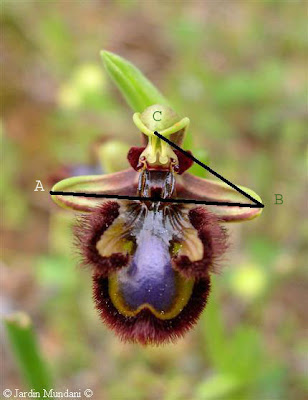

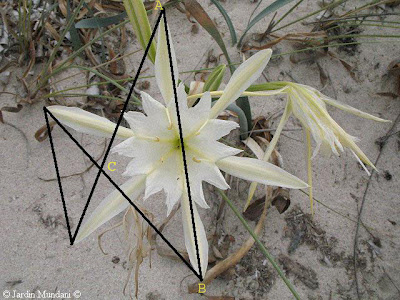

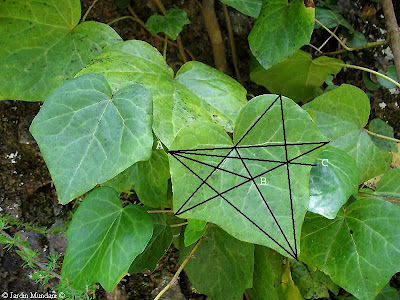


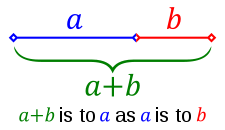










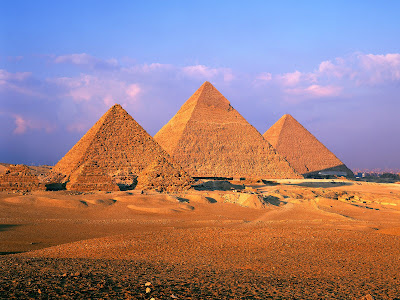














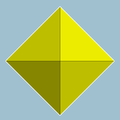





 (also called
(also called 



 If we join mid-points of the dodecahedron's faces, we can get three rectangles all at right angles to each other. What's more, they are Golden Rectangles since their edges are in the ratio 1 to Phi.
If we join mid-points of the dodecahedron's faces, we can get three rectangles all at right angles to each other. What's more, they are Golden Rectangles since their edges are in the ratio 1 to Phi.





